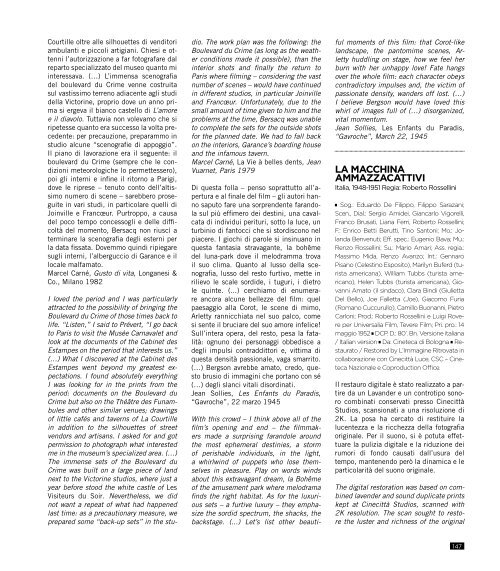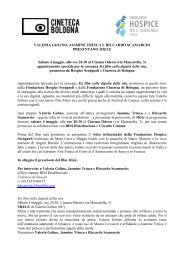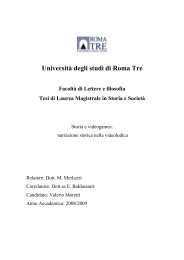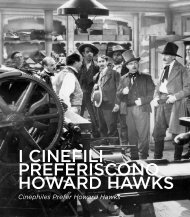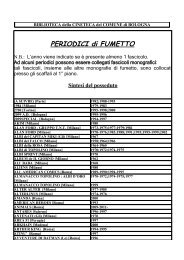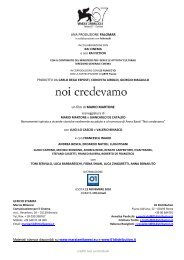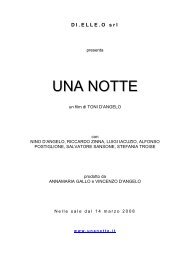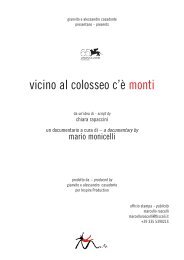Ritrovati & Restaurati sonori.pdf - Cineteca di Bologna
Ritrovati & Restaurati sonori.pdf - Cineteca di Bologna
Ritrovati & Restaurati sonori.pdf - Cineteca di Bologna
You also want an ePaper? Increase the reach of your titles
YUMPU automatically turns print PDFs into web optimized ePapers that Google loves.
Courtille oltre alle silhouettes <strong>di</strong> ven<strong>di</strong>tori<br />
ambulanti e piccoli artigiani. Chiesi e ottenni<br />
l’autorizzazione a far fotografare dal<br />
reparto specializzato del museo quanto mi<br />
interessava. (…) L’immensa scenografia<br />
del boulevard du Crime venne costruita<br />
sul vastissimo terreno a<strong>di</strong>acente agli stu<strong>di</strong><br />
della Victorine, proprio dove un anno prima<br />
si ergeva il bianco castello <strong>di</strong> L’amore<br />
e il <strong>di</strong>avolo. Tuttavia non volevamo che si<br />
ripetesse quanto era successo la volta precedente:<br />
per precauzione, preparammo in<br />
stu<strong>di</strong>o alcune “scenografie <strong>di</strong> appoggio”.<br />
Il piano <strong>di</strong> lavorazione era il seguente: il<br />
boulevard du Crime (sempre che le con<strong>di</strong>zioni<br />
meteorologiche lo permettessero),<br />
poi gli interni e infine il ritorno a Parigi,<br />
dove le riprese – tenuto conto dell’altissimo<br />
numero <strong>di</strong> scene – sarebbero proseguite<br />
in vari stu<strong>di</strong>, in particolare quelli <strong>di</strong><br />
Joinville e Francœur. Purtroppo, a causa<br />
del poco tempo concessogli e delle <strong>di</strong>fficoltà<br />
del momento, Bersacq non riuscì a<br />
terminare la scenografia degli esterni per<br />
la data fissata. Dovemmo quin<strong>di</strong> ripiegare<br />
sugli interni, l’alberguccio <strong>di</strong> Garance e il<br />
locale malfamato.<br />
Marcel Carné, Gusto <strong>di</strong> vita, Longanesi &<br />
Co., Milano 1982<br />
I loved the period and I was particularly<br />
attracted to the possibility of bringing the<br />
Boulevard du Crime of those times back to<br />
life. “Listen,” I said to Prévert, “I go back<br />
to Paris to visit the Musée Carnavalet and<br />
look at the documents of the Cabinet des<br />
Estampes on the period that interests us.”<br />
(…) What I <strong>di</strong>scovered at the Cabinet des<br />
Estampes went beyond my greatest expectations.<br />
I found absolutely everything<br />
I was looking for in the prints from the<br />
period: documents on the Boulevard du<br />
Crime but also on the Théâtre des Funambules<br />
and other similar venues; drawings<br />
of little cafés and taverns of La Courtille<br />
in ad<strong>di</strong>tion to the silhouettes of street<br />
vendors and artisans. I asked for and got<br />
permission to photograph what interested<br />
me in the museum’s specialized area. (…)<br />
The immense sets of the Boulevard du<br />
Crime was built on a large piece of land<br />
next to the Victorine stu<strong>di</strong>os, where just a<br />
year before stood the white castle of Les<br />
Visiteurs du Soir. Nevertheless, we <strong>di</strong>d<br />
not want a repeat of what had happened<br />
last time: as a precautionary measure, we<br />
prepared some “back-up sets” in the stu-<br />
<strong>di</strong>o. The work plan was the following: the<br />
Boulevard du Crime (as long as the weather<br />
con<strong>di</strong>tions made it possible), than the<br />
interior shots and finally the return to<br />
Paris where filming – considering the vast<br />
number of scenes – would have continued<br />
in <strong>di</strong>fferent stu<strong>di</strong>os, in particular Joinville<br />
and Francœur. Unfortunately, due to the<br />
small amount of time given to him and the<br />
problems at the time, Bersacq was unable<br />
to complete the sets for the outside shots<br />
for the planned date. We had to fall back<br />
on the interiors, Garance’s boar<strong>di</strong>ng house<br />
and the infamous tavern.<br />
Marcel Carné, La Vie à belles dents, Jean<br />
Vuarnet, Paris 1979<br />
Di questa folla – penso soprattutto all’apertura<br />
e al finale del film – gli autori hanno<br />
saputo fare una sorprendente farandola<br />
sul più effimero dei destini, una cavalcata<br />
<strong>di</strong> in<strong>di</strong>vidui perituri, sotto la luce, un<br />
turbinio <strong>di</strong> fantocci che si stor<strong>di</strong>scono nel<br />
piacere. I giochi <strong>di</strong> parole si insinuano in<br />
questa fantasia stravagante, la bohême<br />
del luna-park dove il melodramma trova<br />
il suo clima. Quanto al lusso della scenografia,<br />
lusso del resto furtivo, mette in<br />
rilievo le scale sor<strong>di</strong>de, i tuguri, i <strong>di</strong>etro<br />
le quinte. (...) cerchiamo <strong>di</strong> enumerare<br />
ancora alcune bellezze del film: quel<br />
paesaggio alla Corot, le scene <strong>di</strong> mimo,<br />
Arletty rannicchiata nel suo palco, come<br />
si sente il bruciare del suo amore infelice!<br />
Sull’intera opera, del resto, pesa la fatalità:<br />
ognuno dei personaggi obbe<strong>di</strong>sce a<br />
degli impulsi contrad<strong>di</strong>ttori e, vittima <strong>di</strong><br />
questa densità passionale, vaga smarrito.<br />
(…) Bergson avrebbe amato, credo, questo<br />
brusio <strong>di</strong> immagini che portano con sé<br />
(…) degli slanci vitali <strong>di</strong>sor<strong>di</strong>nati.<br />
Jean Sollies, Les Enfants du Para<strong>di</strong>s,<br />
“Gavroche”, 22 marzo 1945<br />
With this crowd – I think above all of the<br />
film’s opening and end – the filmmakers<br />
made a surprising farandole around<br />
the most ephemeral destinies, a storm<br />
of perishable in<strong>di</strong>viduals, in the light,<br />
a whirlwind of puppets who lose themselves<br />
in pleasure. Play on words winds<br />
about this extravagant dream, la Bohême<br />
of the amusement park where melodrama<br />
finds the right habitat. As for the luxurious<br />
sets – a furtive luxury – they emphasize<br />
the sor<strong>di</strong>d spectrum, the shacks, the<br />
backstage. (...) Let’s list other beauti-<br />
ful moments of this film: that Corot-like<br />
landscape, the pantomime scenes, Arletty<br />
huddling on stage, how we feel her<br />
burn with her unhappy love! Fate hangs<br />
over the whole film: each character obeys<br />
contra<strong>di</strong>ctory impulses and, the victim of<br />
passionate density, wanders off lost. (…)<br />
I believe Bergson would have loved this<br />
whirl of images full of (…) <strong>di</strong>sorganized,<br />
vital momentum.<br />
Jean Sollies, Les Enfants du Para<strong>di</strong>s,<br />
“Gavroche”, March 22, 1945<br />
LA MACCHINA<br />
AMMAZZACATTIVI<br />
Italia, 1948-1951 Regia: Roberto Rossellini<br />
█ Sog.: Eduardo De Filippo, Filippo Sarazani;<br />
Scen., Dial.: Sergio Amidei, Giancarlo Vigorelli,<br />
Franco Brusati, Liana Ferri, Roberto Rossellini;<br />
F.: Enrico Betti Berutti, Tino Santoni; Mo.: Jolanda<br />
Benvenuti; Eff. spec.: Eugenio Bava; Mu.:<br />
Renzo Rossellini; Su.: Mario Amari; Ass. regia.:<br />
Massimo Mida, Renzo Avanzo; Int.: Gennaro<br />
Pisano (Celestino Esposito), Marilyn Buferd (turista<br />
americana), William Tubbs (turista americano),<br />
Helen Tubbs (turista americana), Giovanni<br />
Amato (il sindaco), Clara Bin<strong>di</strong> (Giulietta<br />
Del Bello), Joe Falletta (Joe), Giacomo Furia<br />
(Romano Cuccurullo), Camillo Buonanni, Pietro<br />
Carloni; Prod.: Roberto Rossellini e Luigi Rovere<br />
per Universalia Film, Tevere Film; Pri. pro.: 14<br />
maggio 1952 █ DCP. D.: 80’. Bn. Versione italiana<br />
/ Italian version █ Da: <strong>Cineteca</strong> <strong>di</strong> <strong>Bologna</strong> █ Restaurato<br />
/ Restored by L’Immagine Ritrovata in<br />
collaborazione con Cinecittà Luce, CSC – <strong>Cineteca</strong><br />
Nazionale e Coproduction Office.<br />
Il restauro <strong>di</strong>gitale è stato realizzato a partire<br />
da un Lavander e un controtipo sonoro<br />
combinati conservati presso Cinecittà<br />
Stu<strong>di</strong>os, scansionati a una risoluzione <strong>di</strong><br />
2K. La posa ha cercato <strong>di</strong> restituire la<br />
lucentezza e la ricchezza della fotografia<br />
originale. Per il suono, si è potuta effettuare<br />
la pulizia <strong>di</strong>gitale e la riduzione dei<br />
rumori <strong>di</strong> fondo causati dall’usura del<br />
tempo, mantenendo però la <strong>di</strong>namica e le<br />
particolarità del suono originale.<br />
The <strong>di</strong>gital restoration was based on combined<br />
lavender and sound duplicate prints<br />
kept at Cinecittà Stu<strong>di</strong>os, scanned with<br />
2K resolution. The scan sought to restore<br />
the luster and richness of the original<br />
147


